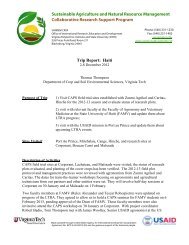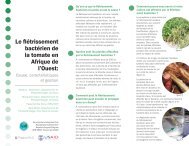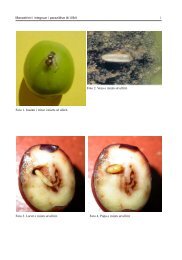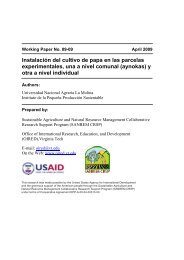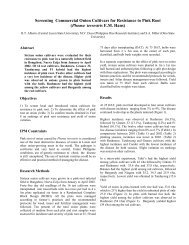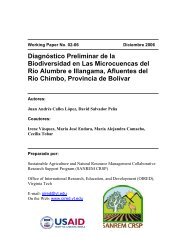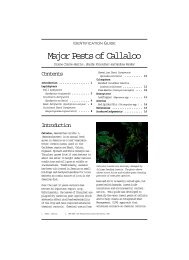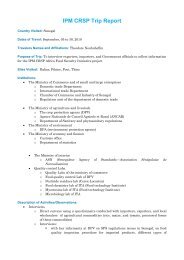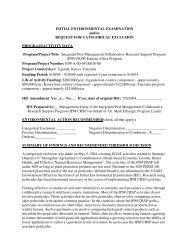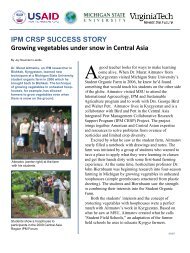Jamaica TRIP REPORT - OIRED - Virginia Tech
Jamaica TRIP REPORT - OIRED - Virginia Tech
Jamaica TRIP REPORT - OIRED - Virginia Tech
You also want an ePaper? Increase the reach of your titles
YUMPU automatically turns print PDFs into web optimized ePapers that Google loves.
<strong>Jamaica</strong><br />
<strong>TRIP</strong> <strong>REPORT</strong><br />
by<br />
Clive Edwards<br />
August 3-9, 1997<br />
Ja - 16
Contact Address for the Management Entity<br />
IPM CRSP<br />
Office of International Research and Development<br />
1060 Litton Reaves Hall<br />
<strong>Virginia</strong> <strong>Tech</strong><br />
Blacksburg, VA 24061-0334<br />
Telephone (540) 231-3513<br />
FAX (540) 231-3519<br />
E-mail: BRHANE@vt.edu<br />
IPM CRSP US Institutions<br />
Lincoln University Rodale Inst. Res. Ctr.<br />
Montana State University Univ of CA/Berkeley<br />
Ohio State University University of Georgia<br />
Penn State University USDA Veg Lab<br />
Purdue University <strong>Virginia</strong> <strong>Tech</strong><br />
Host Country Institutions<br />
Prime Sites Satellite Sites<br />
Guatemala - Agri-lab, ALTERTEC, Ecuador - INIAP<br />
CARE, ICTA<br />
<strong>Jamaica</strong> - CARDI,<br />
Ministry of Agriculture Honduras - EAP<br />
Mali - IER Thailand - Dept of Agriculture<br />
Philippines - NCPC/UPLB, PhilRice Uganda - Makerere University<br />
International Centers<br />
AVRDC - Taiwan CIAT - Columbia<br />
IRRI - Philippines CIP - Peru<br />
Private Sector<br />
The Kroger Company Caito Foods PICO<br />
NGOs/PVOs
JAMAICA <strong>TRIP</strong> <strong>REPORT</strong><br />
by Clive A. Edwards<br />
The Ohio State University<br />
Columbus, OH 43210<br />
August 3-9, 1997
Personnel Involved<br />
Dionne Clark-Harris (Entomologist)<br />
Frieda Eivazi (Soil Scientist - Lincoln University)<br />
Oral James (<strong>Tech</strong>nical Assistant)<br />
Janet Lawrence (Site Coordinator/Entomologist)<br />
Joseph Lindsay (Agronomist; Director, CARDI)<br />
Angela Magnus (USDA Quarantine Supervisor)<br />
Raymond Martin (Pesticide Residue Analyst)<br />
Frank McDonald (Plant Pathologist; Director-Elect, CARDI)<br />
Don McGlashan (Director, Bodles Research Station)<br />
Peter Myers (<strong>Tech</strong>nical Assistant)<br />
Janice Reid (Country Representative/Co-Principal Investigator)<br />
Marcia Smith (Agronomist, Bodes Research Station)<br />
Carol Thomas (Chief Plant Quarantine Inspector, <strong>Jamaica</strong>)
Sunday, August 3, 1997<br />
7.50 pm Arrival, <strong>Jamaica</strong>, Norman Manley International Airport--Met by<br />
Janet Lawrence, IPM CRSP <strong>Jamaica</strong> Site Coordinator.<br />
Monday, August 4, 1997<br />
Reviewing, editing and modifying manuscripts produced by <strong>Jamaica</strong> IPM CRSP:<br />
1. M. F. Huelsman, C. A. Edwards and J. Lawrence, 1997. A Study of the<br />
Effect of Soil Nutrient Levels on the Incidence of Insect Pest and Predators<br />
in <strong>Jamaica</strong>n Sweet Potato (Ipomoea batatus) and callaloo (Amaranthus spp.),<br />
Crop Protection, 8 pp.<br />
2. J. Lawrence, 1997. Pest Management Guides. No. 1: Sweet<br />
Potatoes. CARDI/IPM CRSP, Kingston, <strong>Jamaica</strong>.<br />
3. D. Clarke-Harris, 1997. Pest Management Guides. No. 2: Callaloo.<br />
CARDI/ IPM CRSP, Kingston, <strong>Jamaica</strong>.<br />
4. J. Lawrence, Behac, J. and Freisches S., 1997. Pest Management<br />
Guides. No. 3: Sweet potato weevil. CARDI/IPM CRSP, Kingston, <strong>Jamaica</strong>.<br />
Tuesday, August 5, 1997<br />
8.40 am-12.00pm Visit <strong>Jamaica</strong>n Inspection and Pre-Clearance Facility, Norman<br />
Manley International Airport.<br />
Carol Thomas (Chief Plant Quarantine Inspector), Angela<br />
Magnus (USDA Quarantine Representative), Janice Reid, Janet Lawrence, Frank<br />
McDonald (CARDI).<br />
The status of callaloo, hot peppers and sweet potatoes for export from <strong>Jamaica</strong><br />
and import and pre-clearance to the U.S.:<br />
Sweet Potatoes --export to U.S. not allowed under current import<br />
regulations.<br />
Hot Peppers --Pre-clearance available. About 10% of crops are rejected<br />
due to presence of insects.<br />
Callaloo --Pre-clearance has been temporarily withdrawn. Crops can<br />
still be submitted for inspection. About 30-40% of callaloo crops are<br />
currently rejected for export. Criteria for rejection need to be made clearer<br />
so farmers can avoid rejection. Methods of disinfestation prior to export<br />
need to be examined and guidelines for doing this provided.<br />
The Pre-clearance Facility is being expanded considerably and in the<br />
near future will house representatives from Air <strong>Jamaica</strong> and American Airlines,<br />
plus greatly improved storage facilities for crops awaiting inspection and/or<br />
fumigation. Further discussions between IPM CRSP/CARDI and the pre-clearance<br />
officials could provide the baiss for prepartaion of documents on farmer<br />
guide-lines on critical infestation levels for rejection of sweet potatoes,<br />
hot peppers and callaloo for export.
1.30 pm - 4.45 pm A discussion with Janice Reid, Janet Lawrence, Frank<br />
McDonald, Joseph Lindsay, Dionne Clarke-Harris and Raymond Martin, to review<br />
and suggest potential publications based on past IPM CRSP work. The following<br />
potential publications were identified as a result of this discussion:<br />
Pest Management Guides IPM CRSP/CARDI<br />
• No. 3: Peppers - Raymond Martin<br />
• No. 4: Scouting for Pests of Callaloo and Hot Peppers -Dionne<br />
Clarke-Harris and Raymond Martin<br />
• No. 5: Pesticides Recommended for Use on Callaloo - Dionne Clarke-<br />
Harris*<br />
• No. 6: Pesticides Recommended for Use on Hot Peppers - Raymond<br />
Martin*<br />
• No. 7: Requirements for Clearance and Pre-Clearance of Export Crops<br />
- Janice Reid, Janet Lawrence and Raymond Martin*--(This would include both<br />
insect and mite infestations and pesticide residue levels)<br />
• No. 8: Disinfestation of Callaloo and Hot Pepper for Export -Dionne<br />
Clarke-Harris and Raymond Martin<br />
• No. 9: Identification of Important Weeds in Callaloo, Sweet Potatoes<br />
and Hot Peppers - Janet Lawrence, Phillip Chung, Dionne Clarke-Harris and<br />
Raymond Martin<br />
Proposed Refereed Papers<br />
The following refereed scientific papers are at various stages of<br />
development and preparation:<br />
Dionne Clarke-Harris. Mapping and Analyzing Insect Pest Populations on<br />
Callaloo.<br />
Dionne Clarke-Harris. Action Thresholds for Pest Control on Callaloo.<br />
Dionne Clarke-Harris. Efficacy of methomyl and Bacillus thurgiensis for<br />
control of lepidopterous pests of callaloo.<br />
* Will provide advice based on criteria used in the U.S. State and Federal Recommendations.<br />
Wednesday, August 6, 1997<br />
8.00 am - 9.30 am Travel to <strong>Jamaica</strong> Department of Agriculture -<br />
Bodles Agricultural Research Station.
Meeting to develop details of Workplan for the "Soil Fertility and<br />
Influence of Pests Studies." Project led by Frieda Eivazi.<br />
Present: Don McGlashon (Director), Marcia Smith (Agronomist),<br />
Frieda Eivazi (Lincoln Univeristy), Janet Lawrence, Dionne Clarke-Harris,<br />
Joseph Lindsay (CARDI), Raymond Martin, Peter Myers.<br />
Suggestions offered concerned the number and kind of nutrient<br />
treatments and the design of a sampling program for insect and mite pests<br />
and diseases.<br />
1.30 pm on Travel to Bushy Park--Demonstration of D-Vac equipment for<br />
sampling arthropod pests on plants. A D-Vac suction sampler was brought<br />
from the Ohio State University, on extended loan to CARDI. The use of the<br />
equipment was demonstrated to Janet Lawrence, Dionne Clarke-Harris and<br />
Peter Myers.<br />
Return to Kingston.<br />
Thursday, August 7, 1997<br />
8.00am - 12.00 pm Discussion Meeting with Janice Reid, Janet<br />
Lawrence, Raymond Martin, Dianne Clarke-Harris.<br />
Aims :<br />
1. Current Plant Sampling for Insecticide Residues : A<br />
sampling plan for assessing residues on callaloo and hot peppers on<br />
current visit was developed. This was to sample peppers from four local<br />
markets. These were the three markets sampled in previous years plus<br />
another. Three callaloo and three pepper samples were collected from<br />
each market, their site of origin determined and put into deep freeze<br />
immediately.<br />
Six samples of callaloo and six of hot peppers were collected from<br />
farms selected randomly in the Bushy Park and St. Catherine areas and<br />
placed into deep freeze.<br />
Six samples of callaloo and six of hot peppers were collected from<br />
the Pre-Clearance Facility at Norman Manley Airport and placed into deep
freeze.<br />
All samples were transported back by Clive Edwards to the Ohio<br />
State University for residue analyses.<br />
2.<br />
Planning Residue Work for Year 5 1997-1998 :<br />
a) It was decided to collect Market Basket Samples of callaloo<br />
and hot peppers for pesticide residue analyses, twice a year.<br />
It was also decided to collect a similar number of Field Samples<br />
of the same crops from farmers' fields twice a year for pesticide residue<br />
analyses.<br />
It was decided to collect samples of hot peppers and callaloo from<br />
the Pre-Clearance Facility three times a year for pesticide analyses.<br />
b)<br />
Plants :<br />
Rate of Degradation of Commonly-Used Insecticides on<br />
A field experiment to trace the dissipation of insecticide residues<br />
on callaloo was designed.<br />
Aims<br />
Pesticides that have been recorded as commonly-used on Farmer<br />
Surveys were selected for experimental assessment of the rates of<br />
dissipation from callaloo in the field. Those pesticides appearing most<br />
commonly in the insectcide residue surveys done in 1995 and 1996 were<br />
also included.<br />
Insecticides to be Chosen for the Callaloo Dissipation Study<br />
Common Name Trade Name<br />
Profenophos Selecron<br />
Methomyl Lannate
Methods<br />
Lambdacylhalothrin Karrate<br />
Malathion ---<br />
Diazinon Basudin<br />
Poromopropylate Neuron<br />
Chlorbenzilate ---<br />
Diafenthiuron Pegasus<br />
Callaloo will be sprayed with these insecticides in the field and samples<br />
taken at the following intervals after treatment:<br />
1 hour<br />
2 days<br />
4 days<br />
6 days<br />
8 days<br />
10 days<br />
The insecticides in the leaf samples will be extracted, "cleaned up" and<br />
analyzed.<br />
Results<br />
The results should provide essential data to recommend, appropriate<br />
intervals between spraying and harvesting, under <strong>Jamaica</strong>n climatic<br />
conditions to growers.<br />
2.30 pm - 5.00 pm A seminar "Effects of Pesticides on Soil<br />
Ecosystems" was presented to staff and assistants of CARDI and the<br />
University of the West Indies. There was considerable discussion on<br />
issues such as: the differential effects of various pesticides on different<br />
groups of soil organisms, the role of organic matter in influencing the<br />
efficacy and persistence of pesticides in soil, effects of pesticides on<br />
pests and predators, the effects of pesticides on cycling of nutrients in
the soil, the buildup of plant parasitic nematode populations under<br />
inorganic chemicals compared with organic inputs, and effects of<br />
pesticides on interaction between various groups of soil organisms.<br />
Friday, 8 August 1997<br />
9.00 am 3.00 pm Collection of samples of callaloo and hot peppers for<br />
pesticide residue analyses from the Pre-Clearance Facility at the Norman<br />
Manley Airport, from four local markets and from fields under study in the<br />
Bushy Park area.<br />
The samples were packed in polythene bags in a cooler with only dry<br />
ice for transport to the U.S. for analyses and stored in a deep freeze until<br />
analyzed for residues.<br />
3.30pm - 5.00 pm Closing meeting with Janice Reid, Janet Lawrence,<br />
Dionne Clarke-Harris, Raymond Martin, Dwight Robinson (University of<br />
West Indies) Phillip Chung (RADA).<br />
The potential of light trap networks for assessing flight-periods of<br />
moths and chafers and suction traps for assessing aphid activity was<br />
discussed in terms of setting up such networks in <strong>Jamaica</strong>.<br />
The light traps are cheap to build and experience has shown that<br />
they can be operated on a cooperative basis by teachers and students from<br />
appropriately-located schools. Teachers are provided with workshops to<br />
explain the aims and operation of the project. Each school is provided<br />
with a light trap, containers to keep the moth s collected and a small<br />
collection box with pinned specimens of the key moths associated with<br />
caterpillars attacking callaloo and hot peppers. The students empty the<br />
traps daily and do the moth identifications from a simple key. A network<br />
of up to ten or more traps could provide a distribution map of each species<br />
of moth over the whole growing area or region and additionally when the<br />
adults are on the wing in the various areas. This allows advise to be given<br />
on the optimum time to spray for caterpillar or white grub control. Such a<br />
system is cheap, requires little labor and is very cost-effective as a<br />
warning scheme.<br />
Similarly, the collection of insects, especially aphids, flying at a<br />
height of 10 m above the ground, can be collected in a single Rothamsted
suction trap of the type that are used as a network across Europe. These<br />
traps separate insect catches into hourly and daily batches. If these are<br />
sorted rapidly, preferably by one week, the timing of control sprays can<br />
kill aphids in a timely manner, and minimize spread of virus in a crop such<br />
as hot peppers. One or possibly two such traps in <strong>Jamaica</strong> could provide<br />
an island-wide warning scheme.



